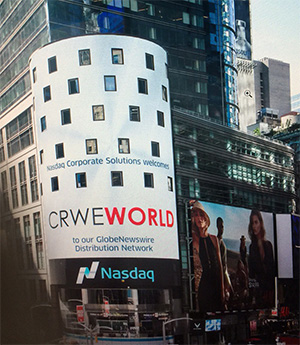Neurocrine Biosciences to Present Wide-Ranging One-Year Data from Phase 3 CAHtalyst™ Pediatric Study at Pediatric Endocrine Society 2025 Annual Meeting
Neurocrine Biosciences to Present Wide-Ranging One-Year Data from Phase 3 CAHtalyst™ Pediatric Study at Pediatric Endocrine Society 2025 Annual Meeting |
| [16-May-2025] |
One-Year Data Show Lasting Reductions in Glucocorticoid Doses and Improvements in Clinical Outcomes with CRENESSITY™ (crinecerfont) in Pediatric Patients with Classic Congenital Adrenal Hyperplasia SAN DIEGO, May 16, 2025 /PRNewswire/ -- Neurocrine Biosciences, Inc. (Nasdaq: NBIX) today announced it will present new data from the Phase 3 CAHtalyst™ Pediatric study showing lasting reductions in glucocorticoid doses in pediatric patients with classic congenital adrenal hyperplasia who received CRENESSITY™ (crinecerfont) for up to one year. In addition, the study showed that for patients on CRENESSITY, adrenocorticotropic hormone, 17-hydroxyprogesterone and androstenedione remained below baseline levels, despite substantially decreased glucocorticoid doses. Results also showed improvements in clinical outcomes, including body mass index and insulin resistance. These data will be presented at the Pediatric Endocrine Society (PES) 2025 Annual Meeting taking place from May 15-18, 2025, in National Harbor, MD. "These results demonstrate that CRENESSITY has the potential to transform the treatment landscape for children and adolescents living with classic congenital adrenal hyperplasia," said Eiry W. Roberts, M.D., Chief Medical Officer, Neurocrine Biosciences. "By simultaneously addressing the underlying hormonal imbalances and allowing for a reduction in glucocorticoid doses, we're seeing improvements in clinical outcomes, including reductions in body mass index and insulin resistance." The Phase 3 CAHtalyst Pediatric study was part of the largest-ever interventional clinical trial program in classic congenital adrenal hyperplasia (CAH) including 103 pediatric patients, four to 17 years of age. The trial consisted of a 28-week, double-blind, placebo-controlled (DBPC) period, during which patients with classic CAH on supraphysiologic glucocorticoid (GC) doses were randomized 2:1 to receive CRENESSITY or placebo, and a 24-week, open-label (OL) period, during which all patients received CRENESSITY. During both the DBPC and OL periods, GC doses were kept stable for the first four weeks and then decreased as tolerated toward more physiologic levels while maintaining or improving androstenedione (A4) relative to Day 1 baseline. Three separate analyses examined the effect of CRENESSITY on:
Long-term, sustained reductions in high GC doses, in addition to improvements in key clinical outcomes, were observed in pediatric patients with up to one year of treatment with CRENESSITY:
CRENESSITY was generally well tolerated, with no adrenal crises reported in the DBPC period. The most common adverse reactions with CRENESSITY were headache (25% versus 6% for placebo), abdominal pain (13% versus 0%), fatigue (7% versus 0%), nasal congestion (7% versus 3%) and epistaxis (4% versus 0%). GC Dosing Regimens in the Phase 3 CAHtalyst™ Adult and CAHtalyst Pediatric Studies Additional data will be presented regarding changes in GC regimens in both adult and pediatric patients with classic CAH. Hydrocortisone dosing frequency was more likely to decrease with CRENESSITY, as was switching to dexamethasone- and prednisolone-free regimens. These changes may reduce both the CAH treatment burden and the risk of adverse effects of chronic treatment with high-dose GCs. Additional poster presentations at the PES 2025 Annual Meeting include:
About Congenital Adrenal Hyperplasia Historically, exogenous glucocorticoids (GCs) have been used to correct the endogenous cortisol deficiency, but doses higher than those for cortisol replacement (supraphysiologic) are needed to lower the elevated levels of adrenocorticotropic hormone (ACTH) and adrenal androgens. However, GC treatment at high doses has been associated with serious and significant complications of steroid excess, including metabolic issues such as weight gain and diabetes, cardiovascular disease and osteoporosis. Additionally, long-term treatment with high-dose GCs may have psychological and cognitive impacts, such as changes in mood and memory. Adrenal androgen excess has been associated with abnormal bone growth and development in pediatric patients, female health problems such as excess facial hair growth and menstrual irregularities, in addition to fertility issues in both sexes. The symptoms of high ACTH may include testicular adrenal rest tumors (TARTs) or ovarian adrenal rest tumors (OARTs). About The CAHtalyst™ Pediatric Study The CAHtalyst Pediatric study included 103 pediatric patients four to 17 years of age. The study tested two questions. The first question evaluated whether four weeks of CRENESSITY treatment could improve androgen control. The second question evaluated whether an additional 24 weeks of CRENESSITY treatment enabled customized glucocorticoid (GC) down-titration while androstenedione levels were maintained or improved. Data from the CAHtalyst Phase 3 studies supported approval of CRENESSITY by the U.S. Food and Drug Administration in December 2024. The open-label extension treatment portions of both studies are ongoing. About CRENESSITY™ (crinecerfont) CRENESSITY comes in capsules and an oral solution. The capsule formulation is available in 50 mg and 100 mg doses. The oral solution is available as a 50 mg/mL strength formulation. For adults 18 years of age and older, the recommended dosage is 100 mg twice daily taken orally with a meal. For pediatric patients four to 17 years of age weighing less than 55 kg (121 lbs), the recommended dosage is based on body weight and is administered twice daily, taken orally with a meal. For pediatric patients weighing more than 55 kg (121 lbs), the recommended dosage is 100 mg twice daily taken orally with a meal. Healthcare providers can work with patients to determine the appropriate formulation for use depending on patient needs. Patients receiving CRENESSITY should continue GC therapy for cortisol replacement. Important Information Approved Uses IMPORTANT SAFETY INFORMATION Do not take CRENESSITY if you: Are allergic to crinecerfont, or any of the ingredients in CRENESSITY. CRENESSITY may cause serious side effects, including: Allergic Reactions. Symptoms of an allergic reaction include tightness of the throat, trouble breathing or swallowing, swelling of the lips, tongue, or face, and rash. If you have an allergic reaction to CRENESSITY, get emergency medical help right away and stop taking CRENESSITY. Risk of Sudden Adrenal Insufficiency or Adrenal Crisis With Too Little Glucocorticoid (Steroid) Medicine. Sudden adrenal insufficiency or adrenal crisis can happen in people with congenital adrenal hyperplasia who are not taking enough glucocorticoid (steroid) medicine. You should continue taking your glucocorticoid (steroid) medicine during treatment with CRENESSITY. Certain conditions such as infection, severe injury, or shock may increase your risk for sudden adrenal insufficiency or adrenal crisis. Tell your healthcare provider if you get a severe injury, infection, illness, or have planned surgery during treatment. Your healthcare provider may need to change your dose of glucocorticoid (steroid) medicine. Before taking CRENESSITY, tell your healthcare provider about all of your medical conditions, including if you are pregnant or plan to become pregnant, or are breastfeeding or plan to breastfeed. Tell your healthcare provider about all the medicines you take, including prescription and over-the-counter medicines, vitamins, and herbal supplements. The most common side effects of CRENESSITY in adults include tiredness, headache, dizziness, joint pain, back pain, decreased appetite, and muscle pain. The most common side effects of CRENESSITY in children include headache, stomach pain, tiredness, nasal congestion, and nosebleeds. These are not all the possible side effects of CRENESSITY. Call your healthcare provider for medical advice about side effects. You are encouraged to report negative side effects of prescription drugs to the FDA. Visit MedWatch at www.fda.gov/medwatch or call 1-800-FDA-1088. Dosage Forms and Strengths: CRENESSITY is available in 50 mg and 100 mg capsules, and as an oral solution of 50 mg/mL. Please see full Prescribing Information. About Neurocrine Biosciences, Inc. The NEUROCRINE BIOSCIENCES Logo, NEUROCRINE and YOU DESERVE BRAVE SCIENCE are registered trademarks of Neurocrine Biosciences, Inc. CRENESSITY, CAHtalyst and CAHtalog are trademarks of Neurocrine Biosciences, Inc. Forward-Looking Statements © 2025 Neurocrine Biosciences, Inc. All Rights Reserved. CAP-CFT-US-0027 05/2025
SOURCE Neurocrine Biosciences, Inc. | |||||||||||||||||||||||
Company Codes: NASDAQ-NMS:NBIX |




















